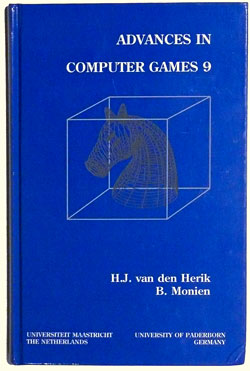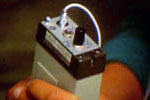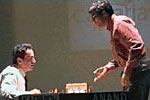 Advances in Computer Games 9", edited by Professors H. J. van den Herik, University Maastricht, and B. Monien, University of Paderborn. It was published by the Universiteit Maastricht in 2001. The paper on Cheating was written and submitted by the author in 2000.
Advances in Computer Games 9", edited by Professors H. J. van den Herik, University Maastricht, and B. Monien, University of Paderborn. It was published by the Universiteit Maastricht in 2001. The paper on Cheating was written and submitted by the author in 2000.
Abstract
Nowadays, players at all levels of chess can profit from computer assistance during a game of chess. This is a new development and a serious problem for the game. This contribution lists the main forms of cheating and provides some occurrences from practice. The most prevailing one (Allwermann at the Böblinger Open) is placed in a historical context by describing previously noticed cases of cheating.
Finally, the problem of cheating is addressed at the highest level of play. What are the possibilities and how can we prevent cheating at this level? Since there is no clear solution, the problem of cheating remains on the list of issues to be addressed very seriously in the near future.
Part 4: Computer assistance at the highest level
Potentially computers can play a decisive role at the very highest levels of chess. This was made very clear to me during the Super GM tournament in Las Palmas in 1997. In round four of this tournament Garry Kasparov played a very nice attacking game against the world’s number two Vishy Anand. I was following the moves with Fritz in the press room, together with some of the grandmasters present there. Here’s how the game went:
Kasparov,Garry (2785) - Anand,Viswanathan (2735) [B92]
Las Palmas (4), 12.12.1996
1.e4 c5 2.Nf3 d6 3.d4 cxd4 4.Nxd4 Nf6 5.Nc3 a6 6.Be2 e5 7.Nb3 Be7 8.0-0 0-0 9.Kh1 b5 10.a4 Bb7 11.Nd5 bxa4 12.Rxa4 Bc6 13.Ra3 Nxe4 14.Na5 Nf6 15.Nxc6 Nxc6 16.Bc4 Nd4 17.Rh3 g6 18.Qd2 Nf5 19.Nxf6+ Bxf6
At this point Kasparov went into a deep think. Jan Timman started to speculate whether White couldn’t play the very forceful 20.g4. Kasparov’s second Yury Dokhoian immediately confirmed: “That’s what he’s looking at!” Yury understands Kasparov’s thinking better than anyone else in the world.

[Event "Las Palmas"] [Site "Las Palmas"] [Date "1996.12.12"] [Round "4"] [White "Kasparov, Garry"] [Black "Anand, Viswanathan"] [Result "1/2-1/2"] [ECO "B92"] [WhiteElo "2785"] [BlackElo "2735"] [Annotator "Kramnik,V"] [PlyCount "126"] [EventDate "1996.12.08"] [EventType "tourn"] [EventRounds "10"] [EventCountry "ESP"] [EventCategory "21"] [Source "ChessBase"] [SourceDate "1997.04.01"] 1. e4 c5 2. Nf3 d6 3. d4 cxd4 4. Nxd4 Nf6 5. Nc3 a6 6. Be2 e5 7. Nb3 Be7 8. O-O O-O 9. Kh1 b5 10. a4 Bb7 11. Nd5 bxa4 12. Rxa4 Bc6 13. Ra3 Nxe4 14. Na5 Nf6 15. Nxc6 Nxc6 16. Bc4 Nd4 17. Rh3 g6 18. Qd2 Nf5 19. Nxf6+ Bxf6 {We started analysing the position with Fritz, and soon we had the following lines (here enhanced with analysis provided by Kramnik and others for ChessBase Magazine vol. 57.} 20. Bd5 (20. g4 $1 Qc8 (20... Nh4 21. g5 $18) (20... d5 $5 21. gxf5 dxc4 22. Qh6 Qd5+ 23. f3 Rfd8 $13) 21. Bd5 $1 (21. Rc3 Qb7+ 22. Bd5 Qb5) 21... Nh4 22. Rg1 $3 (22. Bxa8 {Dolmatov} Qxa8+ 23. f3 e4) 22... g5 23. Rxh4 gxh4 24. g5 Bg7 25. g6 $1 hxg6 (25... Qf5 26. gxf7+ Kh8 27. Bxa8 Rxa8 (27... e4 28. Qf4 Qxf4 29. Bxf4 Rxa8 30. Bxd6 h6 31. Rxg7 Kxg7 32. f8=Q+ Rxf8 33. Bxf8+ Kxf8 34. Kg2 Kf7 35. Kh3 {wins}) 28. Qd5 Rf8 29. Bh6 $1 {and Black has no defense. This final point, found by Fritz, is especially important and clinches the line.}) ( 25... Ra7 26. gxh7+ Kh8 (26... Kxh7 27. Qg5 $18) 27. Rxg7 Kxg7 28. Qh6+ Kh8 29. Qf6+ Kxh7 30. Be4+ Kg8 31. Qg5+ Kh8 32. Qh6+ Kg8 33. Qh7#) 26. Rxg6 Qh3 27. Rg1 $1 Kh8 (27... e4 28. Bxe4 f5 29. Bd5+ Kh8 30. Rxg7 Kxg7 31. Qh6#) 28. Qg5) 20... h5 21. Bxa8 Qxa8 22. Ra3 Rc8 23. c3 Qb7 24. Qd3 Rc6 25. Rd1 d5 26. Ra5 d4 27. cxd4 exd4 28. b4 Nh4 29. f3 Qxb4 30. Rxa6 Rxa6 31. Qxa6 Bg7 32. Qd3 Nf5 33. Bf4 Qb2 34. g3 Kh7 35. Rd2 Qb7 36. Qe4 Qb5 37. Qd3 Qb7 38. Qe4 Qb5 39. Kg1 Qa5 40. Qd3 Ne7 41. Rd1 Nd5 42. Bd2 Qa7 43. Re1 Qd7 44. Kg2 Qa7 45. Kg1 Qa2 46. Re2 Qa1+ 47. Re1 Qa4 48. Rc1 Nc3 49. g4 Qa5 50. Re1 Qc5 51. h3 Bf6 52. f4 h4 53. Qf3 Qb5 54. g5 Bg7 55. Re7 Qb1+ 56. Qf1 Qf5 57. Qe1 Qxh3 58. Rxf7 Qg4+ 59. Kh2 h3 60. Qf1 Ne4 61. Be1 d3 62. Qxh3+ Qxh3+ 63. Kxh3 d2 1/2-1/2

Yury Dokhoian checking the 20.g4 line with Fritz in real time during the game, Kasparov and Anand analyse after six hours of play [video grabs from the CBM 56 multimedia report].
Meanwhile White had played 20.Bd5. The game lasted six hours, Anand defended very tenaciously and at around 10 p.m., much to the disappointment of Kasparov, a draw was agreed.
When he left the stage Garry came into the press room, spotted me and walked straight over. “I couldn't win it, could I, Fred?” he asked, with a troubled look on his face. It was a bit shocking: the world champion and best player of all times consulting a chess amateur, asking for an evaluation of the game he has just spent six hours on!
Naturally Garry wasn't asking me, he was asking Fritz. He knew I would have been following the game with the computer. “Yes, you had a win, Garry. With 20.g4!” My answer vexed him deeply. “But I saw that! It didn't work. How does it work? Show me.” I could not dictate all the lines, but then Yury walked over. Garry and Anand listened in horror while he gave them all the critical lines. All of this was captured on video and published in ChessBase Magazine 56 (Feb 1997).

Kasparov and Anand learning the truth about 20.g4 from his second Yury Dokhoian
The next day Garry did an interview with the German magazine Der Spiegel. He spoke about “Advanced Chess”, a new concept he has developed, which involves playing games in real time with computer assistance. He used the game against Anand from the previous day to illustrate his point. This is what he had to say: “That game provides us with new arguments for Advanced Chess. If I had had a computer yesterday, I would give you the full line with 20.g4 within five minutes. Maybe less. I would enter g4 and check all the lines. I know where to go. It would give me the confidence to play moves like this. Can you imagine the quality of the games, the brilliancy one could achieve?”
In the time since those remarks there have been two Advanced Chess matches in León, Spain. In the first Kasparov was unable to defeat Bulgarian GM Veselin Topalov, who made efficient use of Fritz to defend against the world champion. The match ended in a 3:3 draw, although Kasparov had just demolished Topalov 5:1 in a match without computers. In the following year Vishy Anand played against Anatoly Karpov. Both players were assisted during the game by ChessBase 7.0 and the chess engine Hiarcs 7.32. Karpov was quite inexperienced at operating a computer, while Anand happens to be one of the most competent ChessBase users on the planet. The result was that we were witness to an (unplanned) experiment of man and computer vs man. Karpov didn’t have a chance and was trounced 5:1 by his opponent. I am convinced that a player like Anand, using a computer to check crucial lines during the game, is playing at a practical level of over 3000 Elo points. However, this is the subject for a different article.
Addendum
We recently reported on a game played at the closing dinner at last December's Chess Classic. During this dinner at Simpsons in the Strand they stage a now traditional simul by the players of the Classic against the guests. Most tables have one or more strong chess players whose job is to guide rather than direct. One particularly high-powered table had Rachel Reeves, MP, the Shadow Chief Secretary to the Treasury, who was a UK U14 girls champion, Professor Vinayak Dravid, a leading nanotechnologist from the University of Chicago, the Indian High Commissioner Rajesh N Prasad, Jo Johnson MP, brother of Boris, and Frederic Friedel. Their advisor was Garry Kasparov and they produced the following game. Note that the GMs making each moves are abbreviated: DH = David Howell, LM = Luke McShane, MC = Magnus Carlsen, etc.

[Event "3rd London Chess Classic"] [Site "London"] [Date "2011.12.12"] [Round "?"] [White "LCC GMs"] [Black "Reeves/Johnson"] [Annotator "Pein,Malcolm"] [Result "0-1"] [ECO "A25"] [PlyCount "124"] [EventDate "2011.??.??"] 1. c4 {DH} e5 2. Nc3 {LM} Nf6 3. Nf3 {MC} Nc6 4. g3 {HN} Bc5 5. Bg2 {MA} O-O 6. d3 {VK V} h6 7. a3 {LA} d6 8. b4 {VA} Bb6 9. O-O Be6 10. Bb2 e4 11. dxe4 Bxc4 12. Rc1 {VK} Be6 13. e3 {DH} Re8 14. Nd4 {LA. White has the edge.} Bg4 15. Qd2 {DH} Ne5 16. Nd5 {MA} Nxd5 17. exd5 {VA} Bd7 (17... Bh3 $5 18. Bxh3 $2 (18. f4 $1) 18... Bxd4 $1) 18. h3 $2 {[#]Played by DH - but this is too much. At this point GK just said "wow", nothing more than that.} Bxh3 $1 {Worked out by Rachel and Frederic.} 19. f4 {Played by Luke, who looked at Garry accusingly, but he was innocent(ish).} Bxg2 20. Kxg2 {VK} Ng4 21. Rfe1 {LA} Qd7 22. e4 {MC} Bxd4 23. Qxd4 {HN} f6 {It looks like White has some play but his position is quite loose.} 24. Re2 {MA} Re7 25. Qd3 {VA} Rae8 26. Rce1 {LA} a6 27. Bd4 {DH} h5 28. Rh1 {HN} Qb5 29. Qxb5 {LM} axb5 30. Rhe1 {MA} Kf7 31. Kf3 {MC} g6 32. Bb2 {LM} Rd8 33. Rc1 {HN} Rdd7 34. Rec2 {DH} f5 {Black has a big advantage now and converted it with one or two hiccups.} 35. exf5 {LA} gxf5 36. Bd4 {VA} Kg6 37. Rc3 {VA} Rh7 38. Bf2 {MA} Rde7 39. Bd4 {MC} h4 40. gxh4 {VK} Re4 41. Bg1 { VA} Rxh4 42. Kg3 {VA} Rh8 43. Rxc7 {LA - and all remaining moves by Levon Aronian.} Nf6 44. Kg2 Nxd5 45. Rd7 Nxf4+ 46. Kf1 Ne2 47. Re1 Ng3+ 48. Kf2 Rxe1 49. Kxe1 Ne4 50. Rxb7 Rh3 51. Rxb5 Rxa3 52. Bd4 f4 53. Rb7 f3 54. Rg7+ Kf5 55. Rf7+ Ke6 56. Rf4 Kd5 57. Bh8 Rb3 58. Kd1 f2 59. Ke2 Rb1 60. Rxf2 Nxf2 61. Kxf2 Rxb4 62. Ke2 Kc4 0-1
After the game some of the simul masters said Kasparov had perhaps been too generous with his advice during the game. But he vigorously denied this: "Before the critical sacrifice I said one word: 'wow!' Fred immediately jumped up and started to analyse with Rachel, and they worked out the sacrifice together, in less then a minute." He then proceeded to recount the story about his 1996 game against Anand in Las Palmas, given above, and how at the time it had become clear to him that a single bit of information, passed on to a player at the right moment, could have a decisive influence on the course of a game. "If Fred was allowed to come in and signal 'now!' in the critical position I would have worked out 20.g4 and played it!" That's right, it often needs just one bit of information – 'now!' – to change the result of a game.
– Part five (final) to follow –
Previous parts
 |
A history of cheating in chess (1)
29.09.2011 – Hardly a month goes by without some report of cheating in international chess tournaments. The problem has become acute, but it is not new. In 2001 Frederic Friedel contributed a paper to the book "Advances in Computer Chess 9". It traces the many forms of illicit manipulations in chess and, a decade later, appears disconcertingly topical and up-to-date. We reproduce the paper in five parts. |
 |
A history of cheating in chess (2)
04.10.2011 – Coaching players during the game is probably the most widespread form of cheating (rivaled only perhaps by bribery and the throwing of games). Although this practice began long before the advent of chess playing machines, computers have added a new and dramatic dimension to this method of cheating in chess. You will never guess: who were the pioneers of cheating with computers? |
 |
A history of cheating in chess (3)
18.12.2011 – In January 1999 the main topic of conversation amongst top players like Kasparov, Anand and others: who was the mysterious German chess amateur, rated below 2000, who had won a strong Open ahead of GMs and IMs, with wonderfully courageous attacking chess and a 2630 performance? How had he done it? Turns out it was with unconventional methods, as subsequent investigation uncovered. |


















 Advances in Computer Games 9", edited by Professors H. J. van den Herik, University Maastricht, and B. Monien, University of Paderborn. It was published by the Universiteit Maastricht in 2001. The paper on Cheating was written and submitted by the author in 2000.
Advances in Computer Games 9", edited by Professors H. J. van den Herik, University Maastricht, and B. Monien, University of Paderborn. It was published by the Universiteit Maastricht in 2001. The paper on Cheating was written and submitted by the author in 2000.










